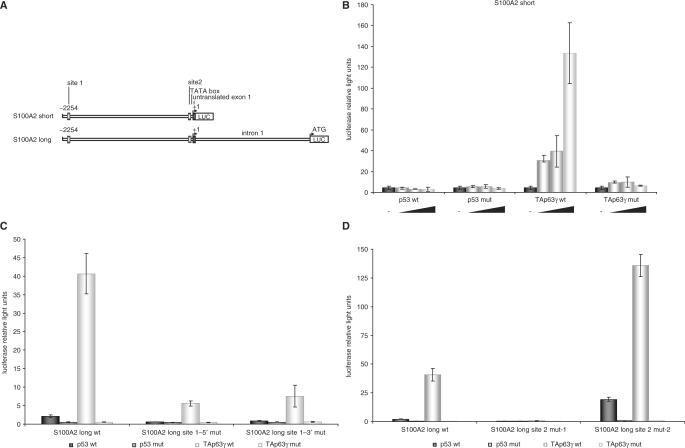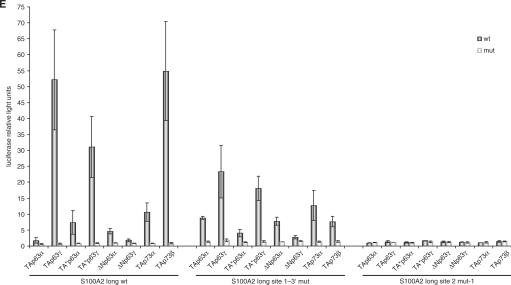Figure 2.
A novel site in the S100A2 promoter different from a previously recognized element mediates transcriptional activation by TAp63γ. (A) Structure of the analyzed promoter fragments of S100A2 upstream of the translational start containing previously published p53 element (site 1) and the newly identified TAp63γ-binding element (site 2). (B) The S100A2 short-reporter is activated by increasing amounts of TAp63γ but not by p53 or DNA binding-deficient mutants of TAp63γ or p53. In SaOS-2 cells 250 ng of the S100A2 short plasmid were cotransfected with increasing amounts starting with 2 ng up to 25 ng of the plasmids expressing wild-type or DNA binding-deficient mutants of TAp63γ or p53. All experiments were standardized to Renilla luciferase activity expressed from cotransfected pRL-null vector. The total amount of DNA transfected was held constant. Averages from four experiments with standard deviations are given. (C) The S100A2 long reporter is activated by TAp63γ and to a lesser extent by p53 but not by DNA binding-deficient mutants of TAp63γ and p53. Mutation of site 1 abrogates p53-mediated but not TAp63γ-mediated transactivation. In SaOS-2 cells, 400 ng reporter plasmid containing wild-type or mutated S100A2 long were cotransfected with 25 ng of the plasmids expressing wild-type or DNA binding-deficient mutants of TAp63γ or p53. Standardization was done as described above. (D) Mutations of the novel consensus element (site 2) influence TAp63γ- and p53-mediated activation of the S100A2 promoter. Transfections were done as described above. (E) Transactivation of S100A2 by several members of the p63/p73 family is mediated by the novel element 2. Plasmids expressing p63/p73 family members or their DNA-binding deficient mutants were transfected with the S100A2 long reporter construct in SaOS-2 cells. Luciferase reporter activities from three independent experiments with standard deviations are shown.


